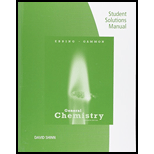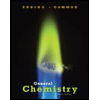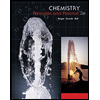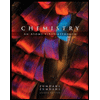
Student Solutions Manual for Ebbing/Gammon's General Chemistry, 11th
11th Edition
ISBN: 9781305673472
Author: Darrell Ebbing, Steven D. Gammon
Publisher: Cengage Learning
expand_more
expand_more
format_list_bulleted
Textbook Question
Chapter 18, Problem 18.128QP
Ksp for silver chloride at 25.0°C is 1.782 × 10−10. At 35.0°C, Ksp is 4.159 × 10−10. What are ΔH° and ΔS° for the reaction?
Expert Solution & Answer
Trending nowThis is a popular solution!

Students have asked these similar questions
Using the appropriate bond energies, calculate the heat of reaction AH for the following reaction:
H-H + CI-CI
2 H-CI
You can find a table of bond energies by using the Data button on the ALEKS toolbar.
Round your answer to the nearest kJ/mol.
Note: For clarity, all lone pairs have been omitted from the molecular structures.
☐
kJ
mol
ค
000
Ar
B
Predict the hydrocarbon, of formula C6H10, needed to prepare the following geminal dibromide upon treatment with excess hydrobromic acid.
Note: The shown product is the only regioisomer formed in this reaction.
HBr
H₂C.
CH3
draw the major product formed with the listed reagents
Chapter 18 Solutions
Student Solutions Manual for Ebbing/Gammon's General Chemistry, 11th
Ch. 18.2 - You have a sample of 1.0 mg of solid iodine at...Ch. 18.2 - Liquid ethanol, C2H5OH(l), at 25C has an entropy...Ch. 18.3 - Prob. 18.2ECh. 18.3 - Prob. 18.3ECh. 18.4 - Calculate G for the following reaction at 25C. Use...Ch. 18.4 - Prob. 18.5ECh. 18.4 - Prob. 18.6ECh. 18.4 - Prob. 18.2CCCh. 18.6 - Give the expression for K for each of the...Ch. 18.6 - Use the data from Table 18.2 to obtain the...
Ch. 18.6 - Prob. 18.9ECh. 18.6 - Prob. 18.3CCCh. 18.7 - Consider the decomposition of dinitrogen...Ch. 18.7 - The thermodynamic equilibrium constant for the...Ch. 18.7 - To what temperature must magnesium carbonate be...Ch. 18 - What is a spontaneous process? Give three examples...Ch. 18 - Which contains greater entropy, a quantity of...Ch. 18 - State the second law of thermodynamics.Ch. 18 - The entropy change S for a phase transition equals...Ch. 18 - Describe how the standard entropy of hydrogen gas...Ch. 18 - Describe what you would look for in a reaction...Ch. 18 - Define the free energy G. How is G related to H...Ch. 18 - What is meant by the standard free-energy change G...Ch. 18 - Prob. 18.9QPCh. 18 - Prob. 18.10QPCh. 18 - Prob. 18.11QPCh. 18 - Prob. 18.12QPCh. 18 - Prob. 18.13QPCh. 18 - Prob. 18.14QPCh. 18 - Prob. 18.15QPCh. 18 - Prob. 18.16QPCh. 18 - Prob. 18.17QPCh. 18 - You run a reaction that has a negative entropy...Ch. 18 - Prob. 18.19QPCh. 18 - Given the following information at 25C, calculate...Ch. 18 - Prob. 18.21QPCh. 18 - Prob. 18.22QPCh. 18 - For each of the following statements, indicate...Ch. 18 - Which of the following are spontaneous processes?...Ch. 18 - Prob. 18.25QPCh. 18 - Predict the sign of the entropy change for each of...Ch. 18 - Hypothetical elements A(g) and B(g) are introduced...Ch. 18 - Prob. 18.28QPCh. 18 - Prob. 18.29QPCh. 18 - Describe how you would expect the spontaneity (G)...Ch. 18 - Chloroform, CHCl3, is a solvent and has been used...Ch. 18 - Diethyl ether (known simply as ether), (C2H5)2O,...Ch. 18 - The enthalpy change when liquid methanol. CH3OH,...Ch. 18 - The heat of vaporization of carbon disulfide, CS2,...Ch. 18 - Predict the sign of S, if possible, for each of...Ch. 18 - Predict the sign of S, if possible, for each of...Ch. 18 - Calculate S for the following reactions, using...Ch. 18 - Calculate S for the following reactions, using...Ch. 18 - Calculate S for the reaction...Ch. 18 - What is the change in entropy, S, for the reaction...Ch. 18 - Using enthalpies of formation (Appendix C),...Ch. 18 - Using enthalpies of formation (Appendix C),...Ch. 18 - The free energy of formation of one mole of...Ch. 18 - The free energy of formation of one mole of...Ch. 18 - Calculate the standard free energy of the...Ch. 18 - Calculate the standard free energy of the...Ch. 18 - On the basis of G for each of the following...Ch. 18 - For each of the following reactions, state whether...Ch. 18 - Calculate H and G for the following reactions at...Ch. 18 - Calculate H and G for the following reactions at...Ch. 18 - Consider the reaction of 2 mol H2(g) at 25C and 1...Ch. 18 - Consider the reaction of 1 mol H2(g) at 25C and 1...Ch. 18 - What is the maximum work that could be obtained...Ch. 18 - What is the maximum work that could be obtained...Ch. 18 - Give the expression for the thermodynamic...Ch. 18 - Write the expression for the thermodynamic...Ch. 18 - What is the standard free-energy change G at 25C...Ch. 18 - What is the standard free-energy change G at 25C...Ch. 18 - Calculate the standard free-energy change and the...Ch. 18 - Calculate the standard free-energy change and the...Ch. 18 - Obtain the equilibrium constant Kc at 25C from the...Ch. 18 - Calculate the equilibrium constant Kc at 25C from...Ch. 18 - Use data given in Tables 6.2 and 18.1 to obtain...Ch. 18 - Use data given in Tables 6.2 and 18.1 to obtain...Ch. 18 - Sodium carbonate, Na2CO3, can be prepared by...Ch. 18 - Oxygen was first prepared by heating mercury(II)...Ch. 18 - Prob. 18.67QPCh. 18 - The combustion of acetylene, C2H2, is a...Ch. 18 - Prob. 18.69QPCh. 18 - Prob. 18.70QPCh. 18 - Acetic acid, CH3COOH, freezes at 16.6C. The heat...Ch. 18 - Acetone, CH3COCH3, boils at 56C. The heat of...Ch. 18 - Prob. 18.73QPCh. 18 - Prob. 18.74QPCh. 18 - Prob. 18.75QPCh. 18 - Ethanol burns in air or oxygen according to the...Ch. 18 - Acetic acid in vinegar results from the bacterial...Ch. 18 - Prob. 18.78QPCh. 18 - Is the following reaction spontaneous as written?...Ch. 18 - Is the following reaction spontaneous as written?...Ch. 18 - Prob. 18.81QPCh. 18 - The reaction N2(g)+3H2(g)2NH3(g) is spontaneous at...Ch. 18 - Prob. 18.83QPCh. 18 - Calculate G at 25C for the reaction...Ch. 18 - Prob. 18.85QPCh. 18 - Consider the reaction CS2(g)+4H2(g)CH4(g)+2H2S(g)...Ch. 18 - Prob. 18.87QPCh. 18 - a From a consideration of the following reactions,...Ch. 18 - For the reaction CH3OH(l)+32O2(g)2H2O(l)+CO2(g)...Ch. 18 - Prob. 18.90QPCh. 18 - Prob. 18.91QPCh. 18 - Tungsten is usually produced by the reduction of...Ch. 18 - For the decomposition of formic acid,...Ch. 18 - Prob. 18.94QPCh. 18 - For the reaction 2Cu(s)+S(s)Cu2S(s) H and G are...Ch. 18 - Prob. 18.96QPCh. 18 - When 1.000 g of gaseous butane, C4H10, is burned...Ch. 18 - When 1.000 g of ethylene glycol, C2H6O2, is burned...Ch. 18 - a Calculate K1, at 25C for phosphoric acid:...Ch. 18 - a Calculate K1, at 25C for sulfurous acid:...Ch. 18 - The direct reaction of iron(III) oxide. Fe2O3, to...Ch. 18 - Prob. 18.102QPCh. 18 - Prob. 18.103QPCh. 18 - Prob. 18.104QPCh. 18 - Prob. 18.105QPCh. 18 - Cobalt(II) chloride hexahydrate, CoCl26H2O, is a...Ch. 18 - Prob. 18.107QPCh. 18 - Hydrogen gas and iodine vapor react to produce...Ch. 18 - Silver carbonate, Ag2CO3, is a light yellow...Ch. 18 - Prob. 18.110QPCh. 18 - Adenosine triphosphate, ATP, is used as a...Ch. 18 - Prob. 18.112QPCh. 18 - Prob. 18.113QPCh. 18 - Prob. 18.114QPCh. 18 - Sodium acetate crystallizes from a supersaturated...Ch. 18 - According to a source, lithium peroxide (Li2O2)...Ch. 18 - Tetrachloromethane (carbon tetrachloride), CCl4,...Ch. 18 - Prob. 18.118QPCh. 18 - Prob. 18.119QPCh. 18 - Prob. 18.120QPCh. 18 - Prob. 18.121QPCh. 18 - Coal is used as a fuel in some electric-generating...Ch. 18 - Hydrogen bromide dissociates into its gaseous...Ch. 18 - Hydrogen gas and iodine gas react to form hydrogen...Ch. 18 - Prob. 18.125QPCh. 18 - Prob. 18.126QPCh. 18 - Ka for acetic acid at 25.0C is 1754 105. At...Ch. 18 - Ksp for silver chloride at 25.0C is 1.782 1010....
Knowledge Booster
Learn more about
Need a deep-dive on the concept behind this application? Look no further. Learn more about this topic, chemistry and related others by exploring similar questions and additional content below.Similar questions
- Propose Williamson ether syntheses for the following compoundsarrow_forwardIdentify all functional groupsarrow_forwardA mixture of CaCO3 and MgC2O4 of unknown mass was heated in a 0.5 L closed rigid vessel to 900 degrees C.at 400C the following reaction occurs:MgC2O4 -> MgO (s) + CO (g) + CO2 (g)At 700C a second reaction occurs: CaCO3 -> CaO (s) + CO2 (g)The solid mass in the vessel was measured to be 3.06 g at 400C and 2.03g at 900CQuestion: What is the partial pressure of CO in both temperatures? (400 and 900C), provide detailed explanation.arrow_forward
- For the following alkyne, complete the reaction sequentially (that is draw the intermediate that we can’t stop at) and then name (complete name) all 3 molecules.arrow_forwardGiven the reaction sequence below, answer the following. A. Provide the structure for A. B. Provide the structure for B (pay attention to stereochemistry). C. Provide the structure for C. D. What are the stereochemical designations for I and II (R/S)?arrow_forwardWhich of the following is the most stable carbon radical?arrow_forward
- Put the following carbon radicals in order of increasing stability.arrow_forwardDraw the major organic product for each of the following reactions (pay attention to stereochemistry).arrow_forwardThere are 2 reactions (that you know of) to achieve the following transformation: One reaction is favored over the other because it avoids a competing reaction. A. Draw the favored reaction scheme (not the mechanism), be sure to include all necessary reagents. B. Draw the reaction scheme that is not favored and include all the possible products.arrow_forward
- Both carbocations and carbon-radicals have trigonal planar geometry. True or Falsearrow_forwardTeflon (polytetrafluoroethene) is prepared via the radial polymerization of tetrafluoroethene. What other reaction conditions (reagent, etc.) are needed to accomplish this? A. NBS, Light B. Heat, Cl2 C. Peroxide, Heat D. H2SO4, H2O, Heatarrow_forwardWhich of the following compounds can be reacted with ethene to prepare 1,1- dichlorocyclopropane? A. CCl4 B. CCl2 C. CHCl3 D. CH2Cl2arrow_forward
arrow_back_ios
SEE MORE QUESTIONS
arrow_forward_ios
Recommended textbooks for you
 General Chemistry - Standalone book (MindTap Cour...ChemistryISBN:9781305580343Author:Steven D. Gammon, Ebbing, Darrell Ebbing, Steven D., Darrell; Gammon, Darrell Ebbing; Steven D. Gammon, Darrell D.; Gammon, Ebbing; Steven D. Gammon; DarrellPublisher:Cengage Learning
General Chemistry - Standalone book (MindTap Cour...ChemistryISBN:9781305580343Author:Steven D. Gammon, Ebbing, Darrell Ebbing, Steven D., Darrell; Gammon, Darrell Ebbing; Steven D. Gammon, Darrell D.; Gammon, Ebbing; Steven D. Gammon; DarrellPublisher:Cengage Learning Chemistry: The Molecular ScienceChemistryISBN:9781285199047Author:John W. Moore, Conrad L. StanitskiPublisher:Cengage Learning
Chemistry: The Molecular ScienceChemistryISBN:9781285199047Author:John W. Moore, Conrad L. StanitskiPublisher:Cengage Learning Chemistry: Principles and PracticeChemistryISBN:9780534420123Author:Daniel L. Reger, Scott R. Goode, David W. Ball, Edward MercerPublisher:Cengage Learning
Chemistry: Principles and PracticeChemistryISBN:9780534420123Author:Daniel L. Reger, Scott R. Goode, David W. Ball, Edward MercerPublisher:Cengage Learning ChemistryChemistryISBN:9781305957404Author:Steven S. Zumdahl, Susan A. Zumdahl, Donald J. DeCostePublisher:Cengage Learning
ChemistryChemistryISBN:9781305957404Author:Steven S. Zumdahl, Susan A. Zumdahl, Donald J. DeCostePublisher:Cengage Learning Chemistry: An Atoms First ApproachChemistryISBN:9781305079243Author:Steven S. Zumdahl, Susan A. ZumdahlPublisher:Cengage Learning
Chemistry: An Atoms First ApproachChemistryISBN:9781305079243Author:Steven S. Zumdahl, Susan A. ZumdahlPublisher:Cengage Learning

General Chemistry - Standalone book (MindTap Cour...
Chemistry
ISBN:9781305580343
Author:Steven D. Gammon, Ebbing, Darrell Ebbing, Steven D., Darrell; Gammon, Darrell Ebbing; Steven D. Gammon, Darrell D.; Gammon, Ebbing; Steven D. Gammon; Darrell
Publisher:Cengage Learning

Chemistry: The Molecular Science
Chemistry
ISBN:9781285199047
Author:John W. Moore, Conrad L. Stanitski
Publisher:Cengage Learning

Chemistry: Principles and Practice
Chemistry
ISBN:9780534420123
Author:Daniel L. Reger, Scott R. Goode, David W. Ball, Edward Mercer
Publisher:Cengage Learning

Chemistry
Chemistry
ISBN:9781305957404
Author:Steven S. Zumdahl, Susan A. Zumdahl, Donald J. DeCoste
Publisher:Cengage Learning

Chemistry: An Atoms First Approach
Chemistry
ISBN:9781305079243
Author:Steven S. Zumdahl, Susan A. Zumdahl
Publisher:Cengage Learning

The Laws of Thermodynamics, Entropy, and Gibbs Free Energy; Author: Professor Dave Explains;https://www.youtube.com/watch?v=8N1BxHgsoOw;License: Standard YouTube License, CC-BY